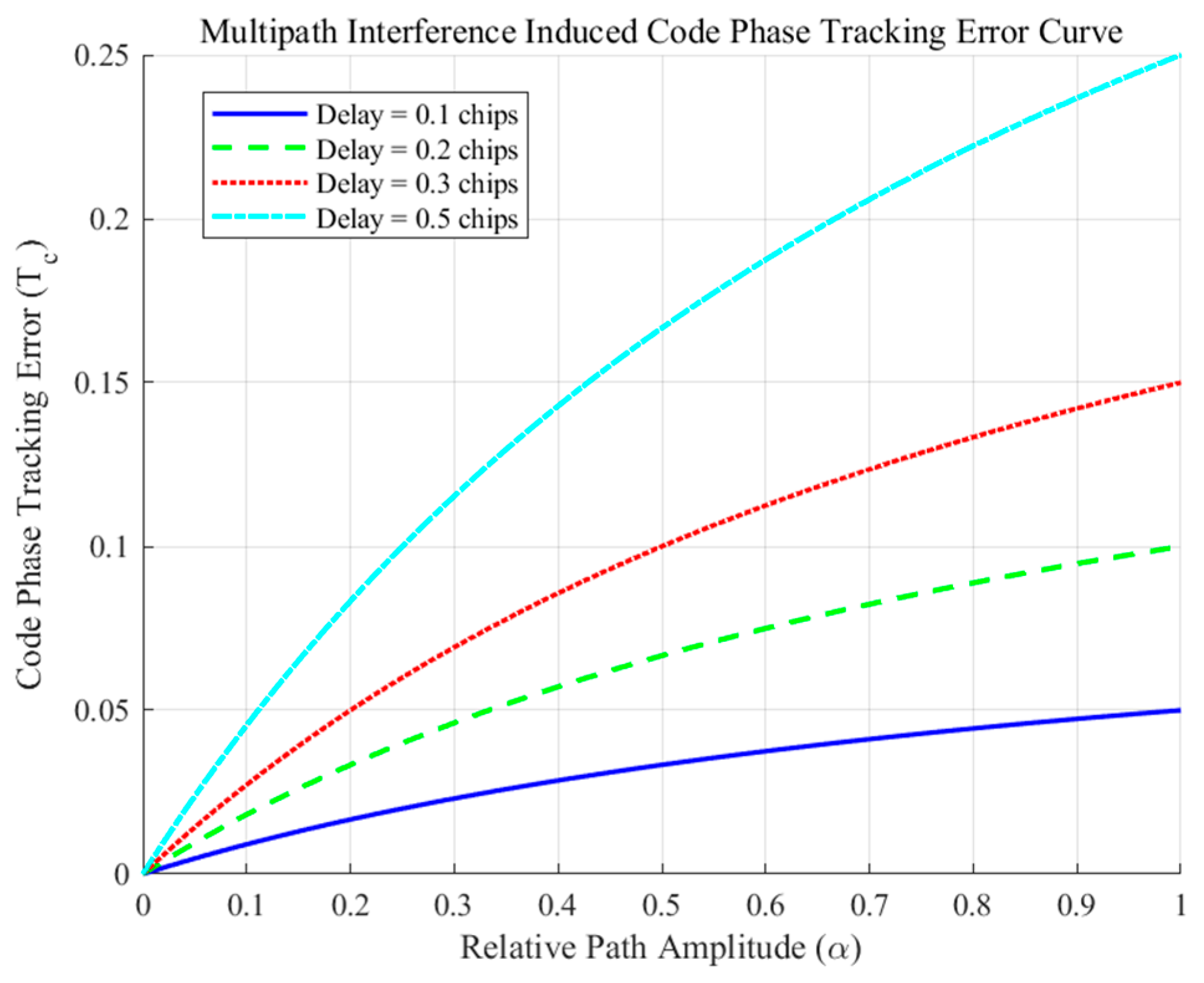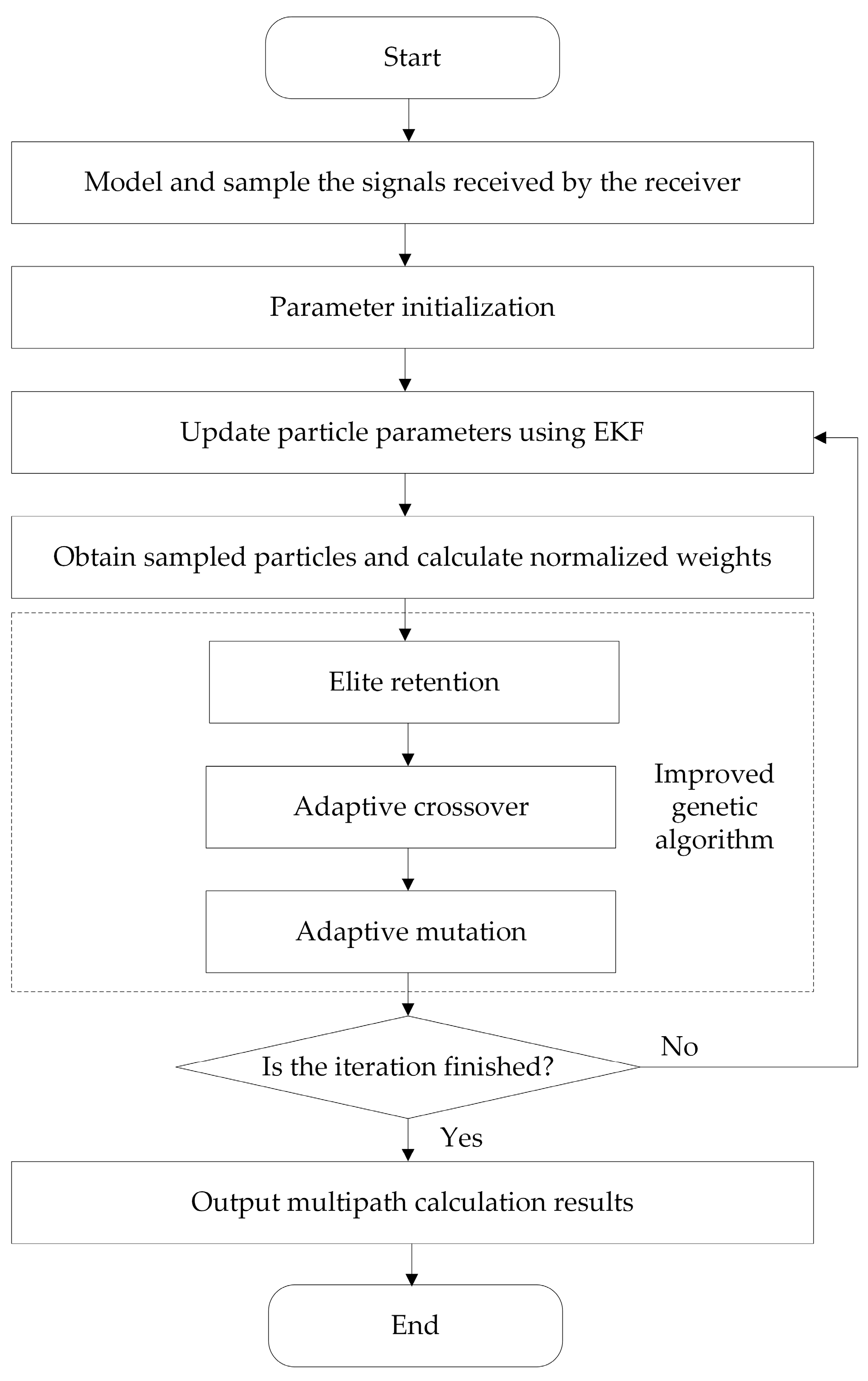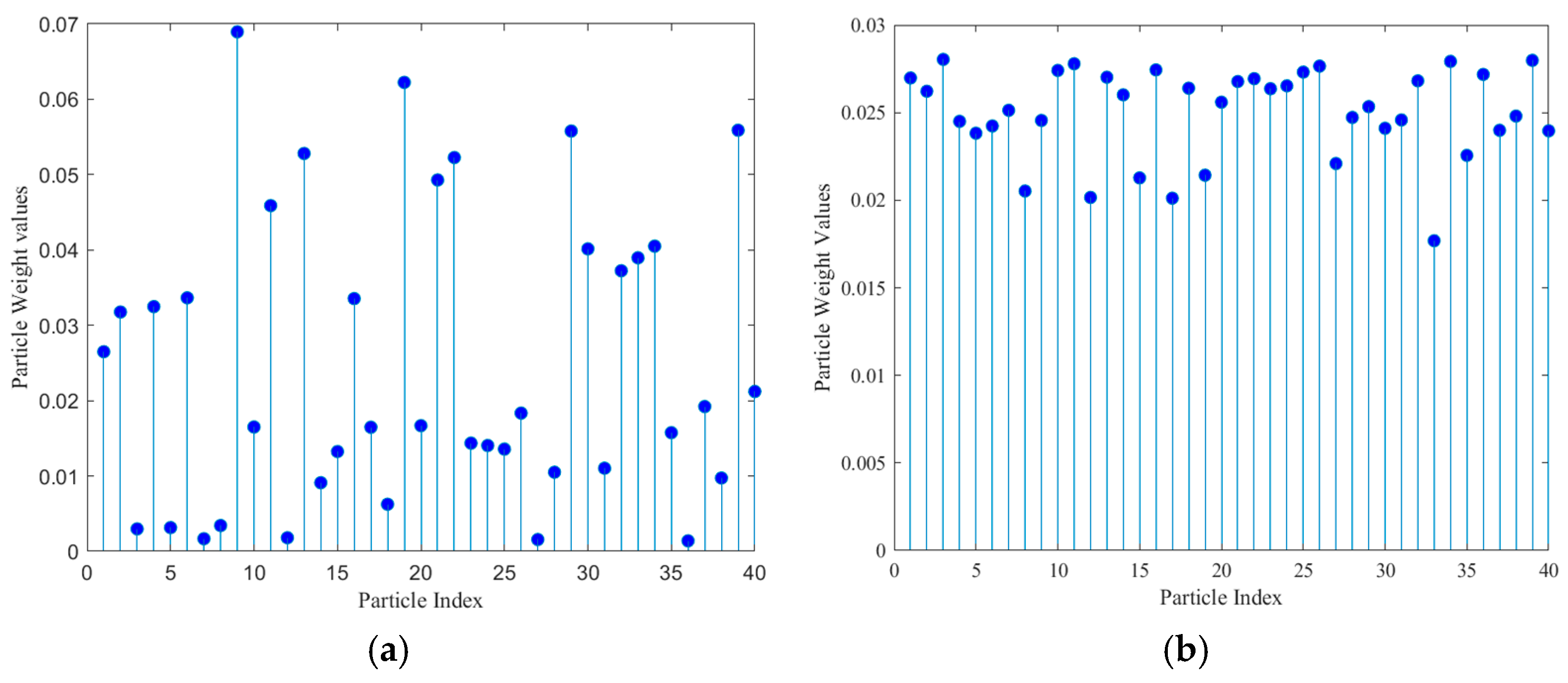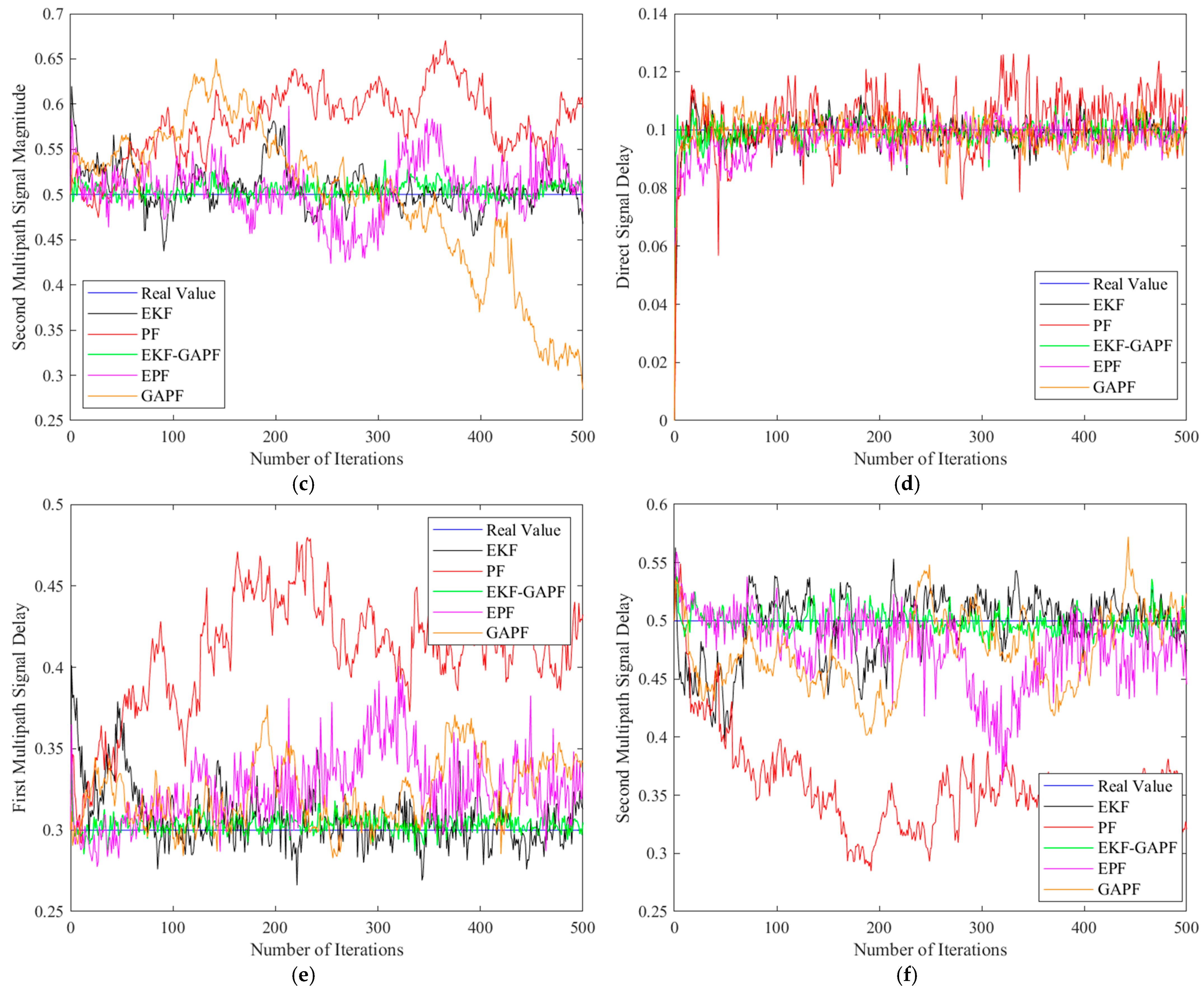Multipath Estimation of Navigation Signals Based on Extended Kalman Filter–Genetic Algorithm Particle Filter Algorithm
Abstract
1. Introduction
2. Signal Model
3. EKF-GAPF-Based Method for Multipath Parameter Estimation
3.1. Preliminary Identification of Parameters
- Initialization:
- Prediction update:
- Kalman gain calculation:
- State estimate update
3.2. Accurate Identification Based on PF
3.2.1. Accurate Identification Process
- Initialize the particle set:
- Perform importance sampling:
- Calculate and normalize weights:
- Resample and state estimation:
3.2.2. Enhancing the Optimization Capability of PF with AGA
4. Simulation and Analysis of EKF-GAPF
4.1. Optimization Capability of AGA
4.2. Comparison of Particle Diversity
4.3. Comparison of Signal Estimation Accuracy
4.4. Parameter Estimation for Two Multipath Signals
5. Conclusions
Author Contributions
Funding
Institutional Review Board Statement
Informed Consent Statement
Data Availability Statement
Conflicts of Interest
References
- Peppa, I.; Psimoulis, P.A. Detection of GNSS Antenna Oscillatory Motion and Multipath Conditions via Exploitation of Multipath-Induced SNR Variations. GPS Solut. 2023, 27, 117. [Google Scholar] [CrossRef]
- Cheng, L.; Chen, J.; Liu, Y.; Zhu, Q. Variable Projection Algorithm for GPS Positioning in Multipath Environments Based on Aitken Acceleration Method. IEEE Trans. Ind. Inform. 2024, 20, 6404–6412. [Google Scholar] [CrossRef]
- Lee, Y.; Wang, P.; Park, B. Nonlinear Regression-Based GNSS Multipath Dynamic Map Construction and Its Application in Deep Urban Areas. IEEE Trans. Intell. Transp. Syst. 2023, 24, 5082–5093. [Google Scholar] [CrossRef]
- Lee, Y.; Hwang, Y.; Ahn, J.Y.; Seo, J.; Park, B. Seamless Accurate Positioning in Deep Urban Area Based on Mode Switching between DGNSS and Multipath Mitigation Positioning. IEEE Trans. Intell. Transp. Syst. 2023, 24, 5856–5870. [Google Scholar] [CrossRef]
- Yan, T.; Wang, Y.; Li, T.; Tian, Y.; Qu, B.; Bian, L. MCSK Signal for LEO Satellite Constellation Based Navigation Augmentation System. In Proceedings of the China Satellite Navigation Conference, Jinan, China, 22–24 May 2023; pp. 295–304. [Google Scholar]
- Chen, Y.; Cheng, J.; Li, X.; Bai, X.; Nie, Z. Research on Tracking Technique Based on BPSK-CSK Signals. Electronics 2024, 13, 1517. [Google Scholar] [CrossRef]
- Zhang, Q.; Zhang, L.; Sun, A.; Meng, X.; Zhao, D.; Hancock, C. GNSS Carrier-Phase Multipath Modeling and Correction: A Review and Prospect of Data Processing Methods. Remote Sens. 2024, 16, 189. [Google Scholar] [CrossRef]
- Fang, J.; Zhang, L.; Zhang, G.; Xu, B.; Hsu, L.-T. Characterization and Validation of GNSS Multipath-Induced Doppler Measurement Error. IEEE Trans. Aerosp. Electron. Syst. 2024; Early Access. [Google Scholar] [CrossRef]
- Wen, W.; Zhang, G.; Hsu, L.-T. Object-Detection-Aided GNSS and Its Integration with Lidar in Highly Urbanized Areas. IEEE Intell. Transp. Syst. Mag. 2020, 12, 53–69. [Google Scholar] [CrossRef]
- Taghdisi, E.; Ghaffarian, M.S.; Mirzavand, R. Low-Profile Substrate Integrated Choke Rings for GNSS Multipath Mitigation. IEEE Trans. Antennas Propag. 2022, 70, 1706–1718. [Google Scholar] [CrossRef]
- Lau, L. GNSS Multipath Errors and Mitigation Techniques. In GPS and GNSS Technology in Geosciences; Elsevier: Amsterdam, The Netherlands, 2021; pp. 77–98. [Google Scholar]
- Liu, X.; Closas, P.; Liu, J.; Hu, X. Particle Filtering and Its Application for Multipath Mitigation with GNSS Receivers. In Proceedings of the IEEE/ION Position, Location and Navigation Symposium, Indian Wells, CA, USA, 4–6 May 2010; pp. 1168–1173. [Google Scholar]
- Jiang, Z.; Zhou, W.; Li, H.; Mo, Y.; Ni, W.; Huang, Q. A New Kind of Accurate Calibration Method for Robotic Kinematic Parameters Based on the Extended Kalman and Particle Filter Algorithm. IEEE Trans. Ind. Electron. 2018, 65, 3337–3345. [Google Scholar] [CrossRef]
- Qin, H.; Xue, X.; Yang, Q. GNSS Multipath Estimation and Mitigation Based on Particle Filter. IET Radar Sonar Navig. 2019, 13, 1588–1596. [Google Scholar]
- Zhiyuan, W.; Lan, C.; Gang, X. An Improved Particle Filtering Algorithm and Its Application in Multipath Estimation. Comput. Eng. 2017, 43, 289–295. [Google Scholar]
- Tian, L.; Sun, X.; Ji, Y. Multipath Signal Estimation Algorithm Based on Genetic Particle Filter. Comput. Simul. 2017, 34, 36–40. [Google Scholar]
- Jee, G.-I.; Kim, H.S.; Lee, Y.J.; Park, C.G. A GPS C/A Code Tracking Loop Based on Extended Kalman Filter with Multipath Mitigation. In Proceedings of the 15th International Technical Meeting of the Satellite Division of the Institute of Navigation (ION GPS 2002), Portland, OR, USA, 24–27 September 2002; pp. 446–451. [Google Scholar]
- Siebert, C.; Konovaltsev, A.; Meurer, M. Development and Validation of a Multipath Mitigation Technique Using Multi-Correlator Structures. Navig. J. Inst. Navig. 2023, 70, 609. [Google Scholar] [CrossRef]
- Mu, X.; Guo, J.; Song, Y.; Sha, Q.; Jiang, J.; He, B.; Yan, T. Application of Modified EKF Algorithm in AUV Navigation System. In Proceedings of the OCEANS 2017, Aberdeen, UK, 19–22 June 2017; pp. 1–4. [Google Scholar]
- Lai, X.; Huang, Y.; Han, X.; Gu, H.; Zheng, Y. A Novel Method for State of Energy Estimation of Lithium-Ion Batteries Using Particle Filter and Extended Kalman Filter. J. Energy Storage 2021, 43, 103269. [Google Scholar] [CrossRef]
- Zhang, J.; Cheng, L.; Zhang, J.; Ni, Z.; Yan, G. Multipath Estimation Algorithm Based on Improved Unscented Kalman Filter. J. Taiyuan Univ. Technol. 2023, 54, 877–884. [Google Scholar] [CrossRef]
- Li, H.; Borhani-Darian, P.; Wu, P.; Closas, P. Deep Neural Network Correlators for GNSS Multipath Mitigation. IEEE Trans. Aerosp. Electron. Syst. 2023, 59, 1249–1259. [Google Scholar] [CrossRef]
- Wang, P.; Morton, Y.J. Multipath Estimating Delay Lock Loop for LTE Signal TOA Estimation in Indoor and Urban Environments. IEEE Trans. Wirel. Commun. 2020, 19, 5518–5530. [Google Scholar] [CrossRef]
- Suzuki, T.; Amano, Y. NLOS Multipath Classification of GNSS Signal Correlation Output Using Machine Learning. Sensors 2021, 21, 2503. [Google Scholar] [CrossRef]
- Jin, R.; Cui, X.; Yan, J.; Xiong, H.; Yang, H.; Gu, M.; Zhen, W. Small Delay GNSS Forwarding Spoofing Detection in Multipath Environment Based on Convolutional Neural Network. IEEE Sens. J. 2024, 24, 24070–24085. [Google Scholar] [CrossRef]
- Chen, J.; Cheng, L.; Gan, M. Modeling of GPS Code and Carrier Tracking Error in Multipath. Chin. J. Electron. 2012, 21, 78–84. [Google Scholar]
- Zhang, J.; Huang, C.; Chow, M.-Y.; Li, X.; Tian, J.; Luo, H.; Yin, S. A Data-Model Interactive Remaining Useful Life Prediction Approach of Lithium-Ion Batteries Based on PF-BiGRU-TSAM. IEEE Trans. Ind. Inform. 2024, 20, 1144–1154. [Google Scholar] [CrossRef]
- Zhou, M.; Long, Y.; Zhang, W.; Pu, Q.; Wang, Y.; Nie, W.; He, W. Adaptive Genetic Algorithm-Aided Neural Network with Channel State Information Tensor Decomposition for Indoor Localization. IEEE Trans. Evol. Comput. 2021, 25, 913–927. [Google Scholar] [CrossRef]
- Alhijawi, B.; Awajan, A. Genetic Algorithms: Theory, Genetic Operators, Solutions, and Applications. Evol. Intell. 2024, 17, 1245–1256. [Google Scholar]
- Li, Y.; Wu, H.; Sun, Y. Improved Adaptive Genetic Algorithm Based RFID Positioning. J. Syst. Eng. Electron. 2022, 33, 305–311. [Google Scholar] [CrossRef]
- Gao, X.; He, D.; Wang, P.; Yu, W. Signal Parameter Estimation Based on ESPRIT with State Space Model for 5 G NR Signals in Indoor and Urban Environments. IEEE Trans. Veh. Technol. 2024, 74, 2276–2291. [Google Scholar] [CrossRef]











| Algorithm | Amplitude of Direct Signal | Amplitude of Multipath Signal | Delay of Direct Signal | Delay of Multipath Signal |
|---|---|---|---|---|
| PF [14] | 0.2038 | 0.2037 | 0.0342 | 0.0534 |
| EKF [18] | 0.0478 | 0.0517 | 0.0119 | 0.0238 |
| EPF [20] | 0.0493 | 0.0479 | 0.0095 | 0.0202 |
| GAPF | 0.0439 | 0.0453 | 0.0130 | 0.0141 |
| EKF-GAPF | 0.0290 | 0.0285 | 0.0065 | 0.0064 |
| Algorithm | Amplitude of Direct Signal | Amplitude of Multipath Signal | Delay of Direct Signal | Delay of Multipath Signal |
|---|---|---|---|---|
| PF [14] | 0.1264 ± 0.0441 | 0.1747 ± 0.0357 | 0.0739 ± 0.0063 | 0.0789 ± 0.0159 |
| EKF [18] | 0.0797 ± 0.0250 | 0.0834 ± 0.0237 | 0.0326 ± 0.0023 | 0.0317 ± 0.0021 |
| EPF [20] | 0.0795 ± 0.0771 | 0.1120 ± 0.9426 | 0.0386 ± 0.2197 | 0.0586 ± 1.0078 |
| GAPF | 0.0801 ± 0.0145 | 0.1366 ± 0.0142 | 0.0622 ± 0.0046 | 0.0624 ± 0.0116 |
| EKF-GAPF | 0.0383 ± 0.0019 | 0.0519 ± 0.0013 | 0.0256 ± 0.0008 | 0.0181 ± 0.0014 |
| Algorithm | Amplitude of Direct Signal | Amplitude of the First Multipath Signal | Amplitude of the Second Multipath Signal | Delay of Direct Signal | Delay of the First Multipath Signal | Delay of the Second Multipath Signal |
|---|---|---|---|---|---|---|
| PF [14] | 0.0451 ± 0.0270 | 0.1416 ± 0.0476 | 0.0972 ± 0.0415 | 0.0546 ± 0.0336 | 0.0776 ± 0.0271 | 0.0703 ± 0.0359 |
| EKF [18] | 0.0199 ± 0.0028 | 0.0539 ± 0.0400 | 0.0505 ± 0.0433 | 0.0062 ± 0.0005 | 0.0388 ± 0.0408 | 0.0499 ± 0.0420 |
| EPF [20] | 0.0137 ± 0.0049 | 0.0427 ± 0.0278 | 0.0428 ± 0.0305 | 0.0057 ± 0.0004 | 0.0353 ± 0.0228 | 0.0428 ± 0.0280 |
| GAPF | 0.0422 ± 0.0391 | 0.1043 ± 0.0512 | 0.1005 ± 0.0574 | 0.0165 ± 0.0087 | 0.0650 ± 0.0342 | 0.0873 ± 0.0423 |
| EKF-GAPF | 0.0092 ± 0.0008 | 0.0224 ± 0.0093 | 0.0232 ± 0.0108 | 0.0054 ± 0.0001 | 0.0073 ± 0.0008 | 0.0127 ± 0.0031 |
Disclaimer/Publisher’s Note: The statements, opinions and data contained in all publications are solely those of the individual author(s) and contributor(s) and not of MDPI and/or the editor(s). MDPI and/or the editor(s) disclaim responsibility for any injury to people or property resulting from any ideas, methods, instructions or products referred to in the content. |
© 2025 by the authors. Licensee MDPI, Basel, Switzerland. This article is an open access article distributed under the terms and conditions of the Creative Commons Attribution (CC BY) license (https://creativecommons.org/licenses/by/4.0/).
Share and Cite
Li, J.; Sun, X.; Ji, Y.; Li, J.; Li, L. Multipath Estimation of Navigation Signals Based on Extended Kalman Filter–Genetic Algorithm Particle Filter Algorithm. Appl. Sci. 2025, 15, 3851. https://doi.org/10.3390/app15073851
Li J, Sun X, Ji Y, Li J, Li L. Multipath Estimation of Navigation Signals Based on Extended Kalman Filter–Genetic Algorithm Particle Filter Algorithm. Applied Sciences. 2025; 15(7):3851. https://doi.org/10.3390/app15073851
Chicago/Turabian StyleLi, Jie, Xiyan Sun, Yuanfa Ji, Jingjing Li, and Long Li. 2025. "Multipath Estimation of Navigation Signals Based on Extended Kalman Filter–Genetic Algorithm Particle Filter Algorithm" Applied Sciences 15, no. 7: 3851. https://doi.org/10.3390/app15073851
APA StyleLi, J., Sun, X., Ji, Y., Li, J., & Li, L. (2025). Multipath Estimation of Navigation Signals Based on Extended Kalman Filter–Genetic Algorithm Particle Filter Algorithm. Applied Sciences, 15(7), 3851. https://doi.org/10.3390/app15073851







